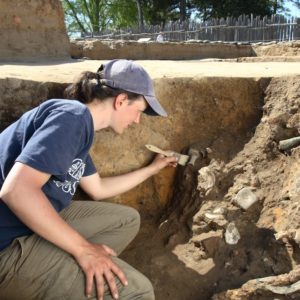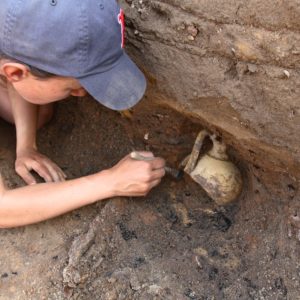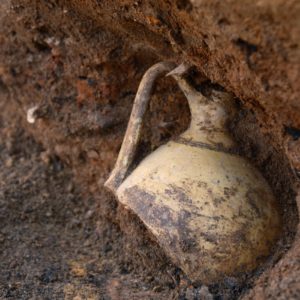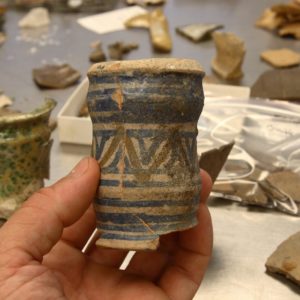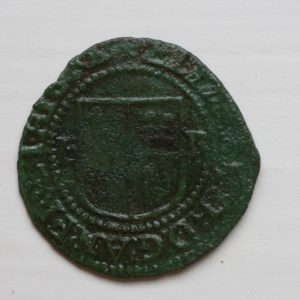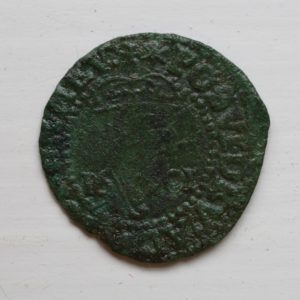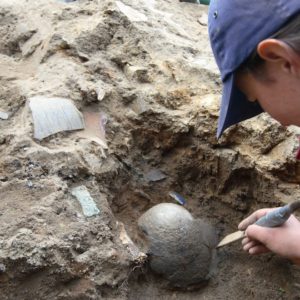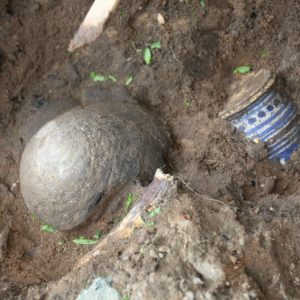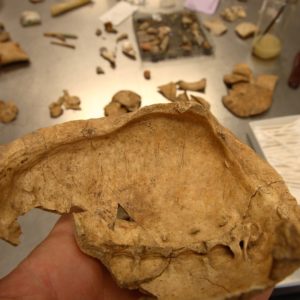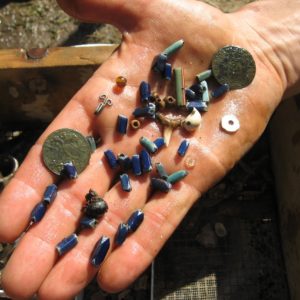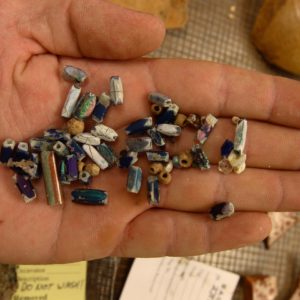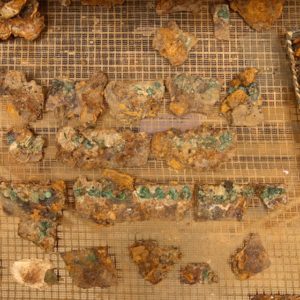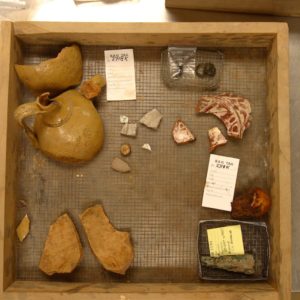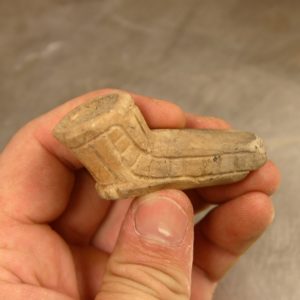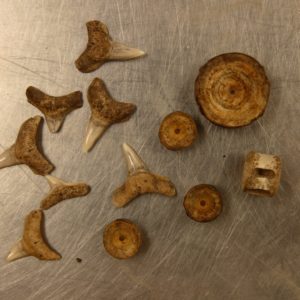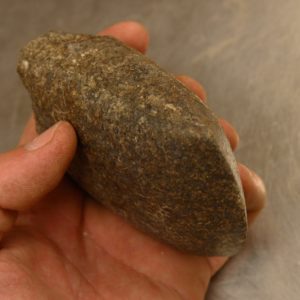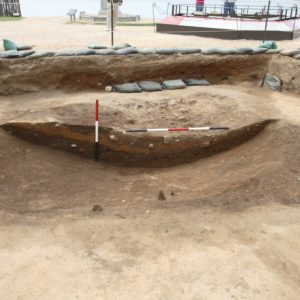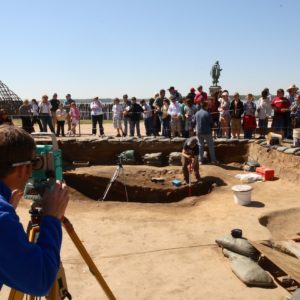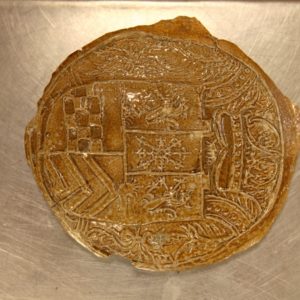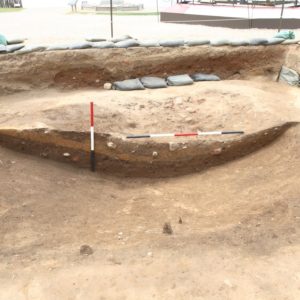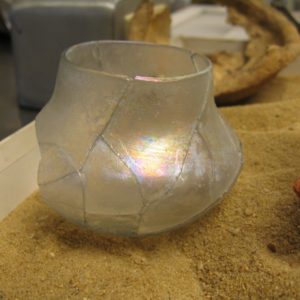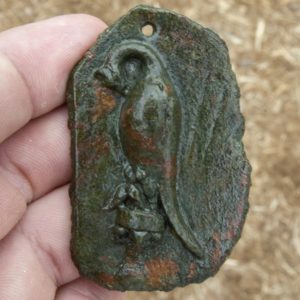Have we found Jamestown’s first well? Thousands of artifacts are pouring out of a subterranean feature located very close to the center of James Fort. The archaeologists of the Jamestown Rediscovery project are more and more certain that the feature is a well because of the remarkable depth of the feature and because the soil layers of the feature have all settled toward the center of the feature rather than uniformly across its breadth. Currently the archaeologists are about three feet below the surface and have already found fort-period artifacts including several pieces of armor, Spanish, German, English, Dutch, and Virginia Indian pottery, coins and tokens, iron and copper alloy buckles, several bandolier cylinders, and a Native American basalt axe known as a celt.
At the end of last year’s dig season, the Jamestown Rediscovery team discovered a subterranean feature while conducting excavations near the center of the fort. As the dig resumed early this month and the top levels of the feature were excavated, the tell-tale signs of a well began to reveal themselves. While the feature is square and roughly 14 feet on each side, the soil at the center of the feature shows a much greater amount of settling than does the soil on the periphery. This suggests that the feature is deeper at the center. This situation is typical of other wells excavated in and around the fort due to the construction methods employed by its builders. When building these deep wells, the colonists had to first dig out a much wider though shallower hole from which to lay the well’s bricks. As they laid more and more courses, they filled the area around the well back in. A probe of the center of the feature indicated that it is at least 9 feet deep.
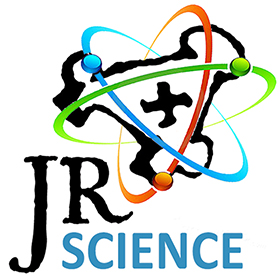 Excavating wells is among the most exciting aspects of conducting archaeology at James Fort because they’ve proven to be such a treasure trove of artifacts. The colonists used wells as trash pits once the water turned sour, and other wells just yards away have yielded “trash” such as helmets, breastplates, guns, a pewter flagon, leather shoes, Bartmann jugs, coins, and even a tobacco seed. Due to the low-oxygen conditions below the water table, even organic materials such as leather have survived 400 years to be found intact by our archaeologists. Metal objects found below the water level are often found largely devoid of the rust that plagues most of the metal objects found above. While the archaeologists are not 100% certain that this feature is a well, it is already yielding thousands of artifacts, many of which are from the early-17th and late-16th centuries.
Excavating wells is among the most exciting aspects of conducting archaeology at James Fort because they’ve proven to be such a treasure trove of artifacts. The colonists used wells as trash pits once the water turned sour, and other wells just yards away have yielded “trash” such as helmets, breastplates, guns, a pewter flagon, leather shoes, Bartmann jugs, coins, and even a tobacco seed. Due to the low-oxygen conditions below the water table, even organic materials such as leather have survived 400 years to be found intact by our archaeologists. Metal objects found below the water level are often found largely devoid of the rust that plagues most of the metal objects found above. While the archaeologists are not 100% certain that this feature is a well, it is already yielding thousands of artifacts, many of which are from the early-17th and late-16th centuries.
A nearly-complete two-handled Spanish jar was just found in the feature. A copper alloy belt buckle has also been found with some of the belt’s leather still attached. The copper in the buckle enabled the preservation of the leather for so long. Plates of a brigandine—a type of armor worn like a jacket—were also excavated from the feature. The protective iron plates were attached to the inside of the garment by copper rivets that would show on the outside. The rivets have survived and are clearly visible on the plates in decorative patterns. Two nearly-complete Virginia Indian clay pots found in the feature are currently being conserved and mended together. The cross-hatching pattern on the outside of the pot, known as simple-stamping, is similar to other Native American pottery found on the site. Other Indian artifacts found in the feature include several projectile points, a basalt axe head, and several shell beads. A pipe made from local clay was also found, but it is not known whether it was made by the colonists or their Indian neighbors.
Another piece of armor, an iron gorget that protected the neck and upper chest area, was found in the feature last week. The colonists wore bandolier cylinders containing gunpowder strung on a belt (bandolier) worn diagonally across their chest. Each cylinder contained enough gunpowder for one shot. Several of these bandolier cylinders have been found in the feature. A Bartmann jug medallion representing a German duchy, a second medallion depicting a pelican, two 1591 Dutch tokens from Groningen, a copper alloy Irish penny minted in 1601, and a bowl made from a box turtle shell are among the other notable artifacts found in the feature. The hundreds of sturgeon scutes excavated from the feature indicate a date in the first quarter of the 17th century when sturgeon was a substantial part of the colonists’ diet. Another interesting find possibly related to their diet is the discovery of a large number of shark teeth and vertebrae in one section of the feature. The teeth appear to be all of the same species and were in close proximity to the vertebrae suggesting that the colonists caught and probably ate the shark.
related images
- Archaeologist Mary Anna Richardson at work in the cellar
- Archaeologist Mary Anna Richardson excavates the Spanish jar
- The Spanish jar
- Archaeologist Mary Anna Richardson excavates some sheet copper
- An apothecary jar
- A 1601 Irish penny (reverse)
- A 1601 Irish penny (obverse)
- Archaeologist Mary Anna Richardson excavates a Virginia Indian clay pot
- Base of Virginia Indian clay pot and an apothecary jar
- A bowl made out of a box turtle shell. Notice the vertical butcher marks.
- Beads and other small finds found in the pit
- An assortment of glass beads
- A partially-mended Virginia Indian clay pot
- Indian shell beads and mussell shell fragments from which they were made.
- Pieces of brigandine armor. The green objects are copper rivets which attached the metal pieces to fabric covering..
- A tray of artifacts. The Spanish jar is at the top left. A buckle is at the top with leather pieces in the plastic bag.
- Neck of an early case bottle
- Groningen token
- A pipe made of local clay. There is some uncertainty as to whether it was made by the colonists or the local Indians.
- Shark teeth and vertebrae
- Indian celt
- A cross-section of the feature
- Archaeologist David Givens uses a transit to map portions of the feature as visitors look on.
- Heavily-rusted gorget
- Medallion from a Bartmann jug
- Beginning the excavation into the pit
- Archaeologist Mary Anna Richardson excavates a cupping glass
- Cupping glass
- Pelican in her piety medallion



